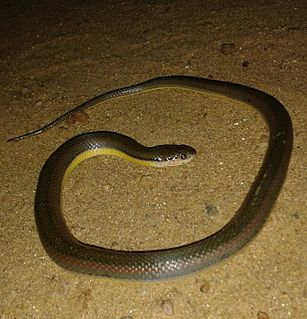François Marie Daudin was a French zoologist.

Indotyphlops braminus, commonly known as the brahminy blind snake and other names, is a nonvenomous blind snake species found mostly in Africa and Asia, but has been introduced in many other parts of the world. They are completely fossorial animals, with habits and appearance similar to earthworms, for which they are often mistaken, although close examination reveals tiny scales rather than the annular segments characteristic of true earthworms. The species is parthenogenetic and all known specimens have been female. The specific name is a Latinized form of the word Brahmin. No subspecies are currently recognized.

Atretium schistosum, the split keelback or olive keelback wart snake, is a species of snake found in South Asia. It is a common and harmless watersnake.

Acrochordus granulatus is a snake species found from India through Southeast Asia to the Solomon Islands. It is known as the little file snake, marine file snake, and little wart snake. It is completely aquatic and almost helpless on land. No subspecies are currently recognized.

Stokes's sea snake is a large species of sea snake in the family Elapidae. It is sometimes placed in its own genus Astrotia. The species is endemic to tropical Indo-Pacific oceanic waters.
Hydrophis caerulescens, commonly known as the dwarf sea snake, is a species of venomous sea snake in the family Elapidae.

Hydrophis cyanocinctus, commonly called the annulated sea snake or the blue-banded sea snake, is a species of venomous sea snake in the family Elapidae.
Hydrophis lapemoides is a species of snake in the family Elapidae known commonly as the Persian Gulf sea snake. This sea snake is native to the Indian Ocean from the Persian Gulf to the coasts of Thailand.
Hydrophis obscurus, commonly known as Russell's sea snake, is a species of venomous sea snake in the family Elapidae.
Hydrophis spiralis, commonly known as the yellow sea snake, is a species of venomous sea snake in the family Elapidae. H. spiralis feeds primarily on eels and is found in muddy, sandy ocean bottoms.

Jerdon's sea snake is a species of venomous sea snake in the subfamily Hydrophiinae.
Hydrophis curtus, also known as Shaw's Sea Snake, short sea snake, but often includes Hydrophis hardwickii is a species of sea snake. Like all Hydrophiinae sea snakes, it is a viviparous, fully marine, and front fanged elapid that is highly venomous. It is collected for a variety of purposes including human and animal food, for medicinal purposes and for their skin.
Hydrophis cantoris, also known commonly as Cantor's narrow-headed sea snake and Cantor's small-headed sea snake, is a species of venomous sea snake in the subfamily Hydrophiinae of the family Elapidae. The species is native to the Indian Ocean and its seas, bays, and gulfs.
Hydrophis viperinus, the viperine sea snake, is a species of Elapidae and Thalassophina viperina is its synonym. It is thought to be naturally rare but widespread. It is venomous.

Colonel Frank Wall was a physician and herpetologist who lived in Sri Lanka and India.
Rhinophis porrectus, or Willey's earth snake, is a species of snake in the family Uropeltidae. It is endemic to Sri Lanka.

The yellow-bellied sea snake is a venomous species of snake from the subfamily Hydrophiinae found in tropical oceanic waters around the world except for the Atlantic Ocean. For many years, it was placed in the monotypic genus Pelamis, but recent molecular evidence indicates it lies within the genus Hydrophis.

Chrysopelea taprobanica, the Sri Lankan flying snake or Indian flying snake, is a species of gliding snake distributed in India and Sri Lanka. It can glide, as with all species of its genus Chrysopelea, by stretching the body into a flattened strip using its ribs. The snake is known as "dangara dandaa - දඟරදන්ඩා" in Sinhala, due to its folding postures.









